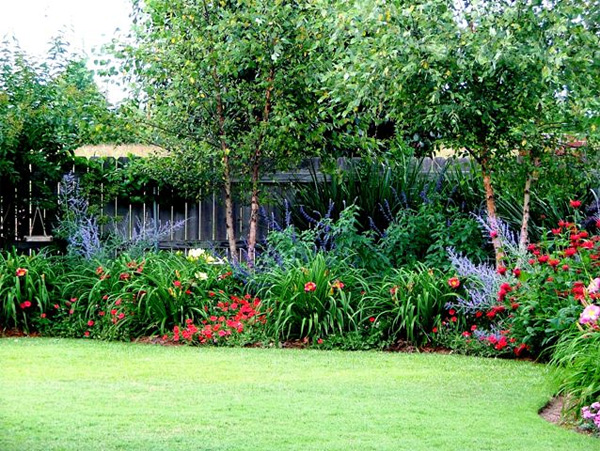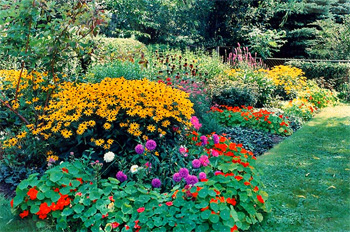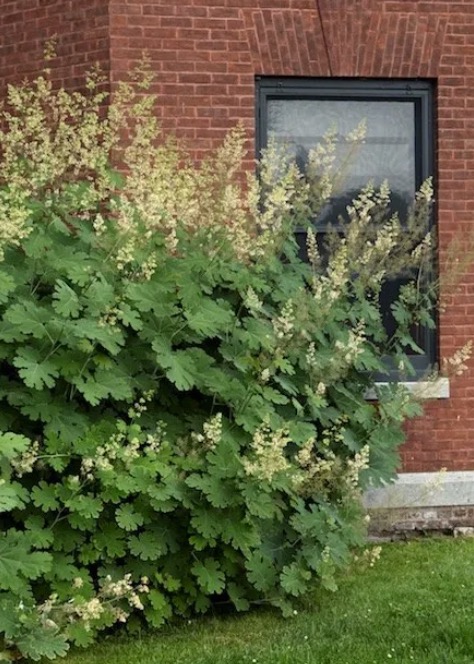When we think of a garden, our visual image is fairly certain to center around an English flower border composed of perennial plants laid out in great drifts of flowing color, relieved by masses of white lilies and accented with towering spires of blue. It expresses the beauty of form and color that every real lover of flowers tries to create to the best of his ability and resources.
Other Kinds of Gardens
A variation of the all-perennial border or garden is the mixed border. This type of garden includes many basic perennials such as daylily and phlox, but in addition utilizes groups of annuals and biennials, and perhaps some of the spring-flowering bulbs like tulips and hyacinths. Its advantages over the all-perennial garden are flexibility of design, greater masses of color over a longer season, and often lower cost and easier maintenance.
A third type of flower garden may be one composed entirely of annual plants. These can be arranged in artistic groups to make the best visual impact possible, or they can be grown in practical rows, to serve mostly as a source of cut flowers.
Of course styles of gardens change as do fashions in the architecture of the houses they surround. And cultural patterns and economic factors affect the types of gardens in vogue. Smaller properties and the demand for low maintenance (proper maintenance is the great lack of most American gardens when they are compared with their foreign counterparts) have resulted in a fourth type of flower garden. It involves the use of a few plants or as many as you wish, annuals or perennials or both, in a variety of ways and situations, depending on where you think your property can be enhanced by their addition. This kind of garden so prevalent over the entire nation today might be described as an 'accent garden'.
 A beautiful perennial border set against a wood fence. Some annual petunias are also used here to good effect. Even though the birch trees are now on the small side, they may be too big one day.
A beautiful perennial border set against a wood fence. Some annual petunias are also used here to good effect. Even though the birch trees are now on the small side, they may be too big one day.Image from The Garden Guru.
Wherever and however flowers are used, they stand out as color accents in the overall landscape. You are aware of this kind of a garden everywhere: it may be a small bed of petunia plants nestled against shrubbery in a shopping mall. It may be one or three daylily plants that a friend has set against an ancient boulder that existed long before her ranch-style house was built. Or it may be a narrow border of sweet alyssum along your neighbor's front walk or around her flagstone patio. Its great merits are flexibility and simplicity, and such a kind of flower gardening is suitable to any property.
But in all these gardens, the basic principles of growing the flowers, and the kinds that can be used, are much the same.
Planning a Border
Now let's return to that first grand picture of a flower garden - the all-perennial or mixed border, the epitome of the flower garden today, yesterday, and tomorrow.
Start with a plan on paper drawn to a large scale so notes may be made directly on the plan. Ideally the border should be at least 5 to 8 feet deep.
The Site
The ideal site is close to the house; preferably it should face south or south-west (in the northern hemisphere), but this is not of great consequence if it has sun and is several feet from the robbing roots of trees or shrubbery. Keep the border at least 2 to 3 feet away from any large tree.
In addition to a hedge, a good background may be a rough-textured wall, a view of distant trees or shrubbery, or a low fence covered with climbing roses. Above all there should be surrounding relief, and nothing sets off the border better than a stretch of lawn. It is better to have a smaller border than to deprive it of the grass setting. Free-form, "island" beds (roughly kidney or crescent shaped) may fit into the landscape scheme. They are most often planted with shrubs, but there is no reason why perennials and annuals can't be used. If such beds are used, plant the high-growing plants toward the center, then the medium-sized ones and the edging plants on the sides.
Selection of Plants
Selection of plants for the flower border may seem like a weighty problem, but it is really one of the most pleasant aspects of garden planning. Studying the plant lists and looking up the descriptions of plants will help you. Use nursery catalogs and reference books found in garden centers, horticultural societies, and your public libraries.
10 points to guide you in selection of plant material:
- Length of life of the plant. Is it annual, biennial, or perennial?
- Height and lateral spread or breadth.
- Growing habit: prostrate, erect or climbing.
- Time and length of flowering period.
- Color of flowers and foliage; persistence of foliage and decorative effect.
- Moisture, soil, and plant food requirements.
- Sun or shade loving?
- Hardiness in a given region.
- Does the plant spread freely?
- Susceptibility to disease and insects.
In planning the material for an all-season, mixed border, select key plants for line, mass, color and dependability. Try to avoid stiffness caused by too regular an arrangement. Do not place the plant groups in regular lines, like rows of cabbages, but in sections which are wider than they are deep. This gives each group a chance to be seen to good advantage from the front of the border.
Of course taller plants should be at the rear, then those of medium height, with the dwarfs in the front. This does not mean that some of the taller plants should not come out into middle ground or the medium-tall toward the front. For the charm of irregularity, break up height lines as well as planting lines. The aim is to imitate the irregular way in which nature grows her plants and still place them in order for display, within the limits of space. Also, strive for proportion; if the border is very narrow, tall plants should be abided except for occasional accent. The border will appear top-heavy if it is too tall and narrow. Groups should be of sufficient size for display. Large masses of one-of-a-kind plants in a border are seldom successful. Borders which are more than 8 feet wide should have a 2-foot service path behind them so that you can walk to the back side of the garden without going through the plants.
Is it possible to have continuous bloom in a flower garden? The answer is certainly "yes" if you will settle for groups of color in sections of the garden - rather than for a complete blanket of color from spring to fall. To achieve the latter condition, you would need at your beck and call an array of greenhouses, cold frames, nursery rows, and an army of gardeners who would add and remove plants as they come in and out of bloom. There are very few ever-blooming flowers, despite the claims of over-zealous nurserymen. Yet very colorful gardens can be achieved with annuals, bulbs, and perennials that have especially long flowering seasons.
In planning a border, it is also wise to consider when the garden should be at its color peak. If August is vacation time, then common sense dictates that you choose plants that reach their perfection in spring and early summer. If you start your borders with simple plants, hardy in your locality, they will need little coddling.
Edging a Flower Bed
Stone and brick edgings are effective, but it is difficult for a mower to get close enough to do a good job of cutting. Extruded concrete curb-type edging is popular in some areas and seems to hold up to wear over the years. But, the grass will grow tall and scraggly against them and must be trimmed with shears or a "weed eater".
Plastic strips are available that can be molded to fit curves and placed less than an inch above the ground to permit the mower to pass without interference. Although it is not uncommon to see this kind of edging occasionally knicked by the mower. There is also plastic edging that looks like brick or pieces of stone that can be used. But, the plastic edging will break down in sunlight over the years much quicker than the stone, brick, or concrete options.
Concerning the use of small plants for edgings, be sure they are compact and full of foliage and have a long season of blooming. The dwarf compact petunia, Nierembergia (or cup-flower), dwarf ageratum, and the old standby sweet alyssum, can all be kept under control and be effective color fillers.
Hardy candytuft (Iberis sempervirens) is the ideal perennial edging in sections where it will not burn in the winter sun. It has white flowers in masses and evergreen foliage. Other dwarf perennials, selected for succession of bloom are: Arabis alpina, Alyssum saxatile, dwarf asters, Campanula carpatica, dianthus, Depeta mussini, pulmonary, sweet William, Veronica incana. These, planted in bands which overlap slightly, and interplanted with small bulbs, will give a good effect, and form a transition from the low edge to the higher plants in the beds.
Midsection and Background
The middle section of a mixed border uses taller plants than the front or edging strip but by no means should they all be of the same height. The aim is to create an undulating effect of blending and contrasting colors, forms and textures. Some groups of low-growing plants from the foreground must dip into this section, and some taller plants from the background should be brought forward.
No matter whether your border is 10 feet wide or 5 feet wide, or whether it's 60 feet long or only 20, this middle section between foreground and background plant material is most important. Here the skill of the gardener is tested. He or she must contrast rounded flower shapes with spiky forms, utilize assets provided by varying foliage colors and textures, and, finally, think like an artist in planning his or her color effects.
Most of the major perennials can be classified as middle-of-the-border subjects as their heights fall between 18 and 36 inches. There are many varieties of annuals, notably zinnia, marigold, and snapdragon, of neat growth that are also suitable. A random list of medium-height, reliable perennials includes the following: astilbe, many daylillies, bearded iris, blue salvia (Salvia farinacea), baby's breath, sweet William, peony, shasta daisy, Canterbury bells, veronica, nepeta, yarrow, summer phlox, bee balm, chrysanthemum, coral bells, columbine, bleeding heart, gas plant, and lupine.
Background plants are important, too, and while the list of reliable ones may not be as varied or extensive as the list of medium-height plants, there are plenty to select from. Some are bushy enough to be planted as individual accents, especially in the case of narrow or short gardens, but most plants - as elsewhere in the border - are most effective in groups of three, four, or five.
Good background plants include the following: delphinium, tall varieties of summer phlox, dusty meadow rue (Thalictrum glaucum), false indigo, hollyhock, foxglove, thermopsis, monkshood, globe thistle, and boltonia. A few of these, like plume poppy* which grows up to 8 feet, are much too tall for borders restricted in length and width.
Beginning as well as more advanced garden makers tend to be impatient and often expect too much the first year from their new flower garden. Great borders are not usually made in one season. Many perennials, peony and gas plant for instance, need a few years to become established before giving their best performance. Also, inevitably, mistakes will be made. Yet the failure of one planting does not spoil the season. Some continuous bloom from spring to fall is feasible by selection. The garden need not go dead in midsummer, especially when annuals are used.
Annuals are the answer to the vacant space problem. The little effort needed to raise them coupled with their low cost and easy maintenance make them very popular.
They make the finest of cut flowers, and used in a border of their own or among the dominating perennials, they have many points of value. In rented property or for a short season at a summer home they have no equal.
*There are many warnings about planting plume poppy! It can become invasive very easily. Put it in a place where 1) it cannot spread past it's borders (like an isolated flower bed next to the garage), or 2) you don't mind it taking over a section of your yard.
 A well maintained perennial border garden in Melbourne.
A well maintained perennial border garden in Melbourne.Image from Wikimedia.

